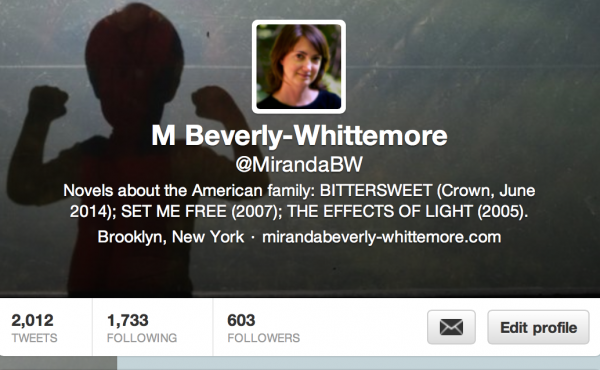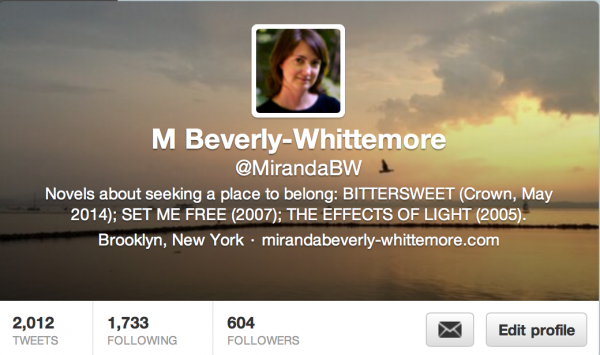This is part of the Bittersweet Book Launch case study, where Dan Blank and Miranda Beverly-Whittemore share the yearlong process of launching her novel. You can view all posts here.
by Miranda Beverly-Whittemore
Yesterday I had a great catch-up conversation with Megana, my best friend from college. She lives across the country with her husband and four kids. We have the kind of long-distance intimacy in which we speak for a few hours every six months or so, and it’s as though no time has passed. Except that when it comes to books and children, six months really matter. Today I asked about her new baby, and she asked about my son, and we regaled each other with the best family tales we’ve collected since our last conversation.
Then she asked about the latest on Bittersweet. She’s not in the book biz, but she’s known me long enough to know how it works, and I was able to fill her in about the book’s foreign sales and my May pub date and the new work I’ve been doing with Dan. I threw around some lingo—namely “Author Platform”—and she stopped me right there.
“What does that mean?” she asked.
Sometimes it can be so, so helpful to go back to square one. “Okay,” I began, trying to figure out how to streamline my jumble of thoughts, “So take my Twitter account, and my Facebook page and my website. All those disparate pieces should be telling the same story about me. They should be aligned to my brand.”
“So your brand—what’s that?”
“It’s the central truth about me. The story I want to tell about who I am.”
“And what’s that story?”
I sighed as I tried to gather my wits. “My background. My thoughts about the world. What I like to read and think about. The idea is to create a consistent online self who can be trusted by those who engage with me. So that someone who reads my blog knows that when they dip in every few days, they can expect consistency—that I’ll be writing about or posting articles or entries that they will find interesting. That if they buy my book, the brand I’ve put out there will only deepen their experience of reading it.”
“And how honest is that story of your brand? What if there’s stuff about yourself you don’t want to have be part of it? I’ve noticed, for example, that your Facebook page seems less intimate than it used to be. It’s still personal, but it’s more of a public persona.”
She was getting to the heart of the beast I’ve been wrestling with—how to balance being personal, accessible and generous, while protecting my intimacy. How to weave the fabric of my life/ experience/ career into a single, strong thread that is truthful, and enticing, and relatable. How to craft my personal narrative into a marketing tool without losing myself. How to leave out the bits that don’t quite fit.
“You know who balances her real self and her persona really well? Nicole.” Megana was talking about my friend Nicole Caccavo Kear, whose forthcoming memoir, Now I See You, is due out from St. Martin’s in 2014. “Her blog is just so so so relatable. The other day I was reading a parenting book, and I remembered something she’d written about her kids on her blog, and I thought about emailing her right then and there with the advice I was reading—I would have done that even if I hadn’t met her, because her blog makes me feel like I know her much better than I do. I laugh to myself when I think about her family and her insights on parenting. And even if I hadn’t met her, I would buy her book when it comes out.”
There—right there—is an example of Author Platform doing its work. I admire Nicole’s ability to put how she really talks (with, okay, a few less swear words) onto the page. Having a conversation with her, or reading her blog, or reading her book, you come to the same conclusion: she’s funny and cynical and warm in the best ways. She is consistently herself, a self that is delightful to know. A self both Megana and I want to return to.
What bloggers/writers/websites do find to be similarly successful in striking that balance? If you have an online presence as an author, how do you balance being accessible with protecting your intimacies?


